Are Wrestling Shoes Good for Lifting: Here’s Why It’s Worth the Try
Author:
Unlock your full potential by engaging with our experts and community! Have questions about your fitness journey or looking for expert advice on weightlifting techniques? Don’t hesitate — leave a comment below and Ihor Shymechko will provide a personalized answer and insights to help you reach your goals.
Torokhtiy is reader-supported. Some links are affiliate links, and we may earn a commission at no extra cost to you. See our disclosure page for details.
Wrestling shoes are quite versatile that some lifters prefer to wear them when weightlifting over lifting shoes. But are wrestling shoes good for lifting? In this article, we find out if you’re better off training with a pair of wrestling shoes or not.
Are wrestling shoes good for lifting? Yes, powerlifters frequently choose to lift while wearing wrestling shoes. There are various benefits to wearing wrestling shoes for weightlifting. Wrestling shoes provide support, offer greater grip, are lightweight, and shield your ankles from injury, making them ideal for lifting weights.
Reasons to wear wrestling shoes for lifting
Improves grip and balance
Due to their 0mm heel-to-toe drop, wrestling shoes are excellent for weightlifting by putting your feet into a flat position. Heel-to-toe drop, for instance, may not be the biggest concern for most lifters and athletes taking on fitness exercises, and in this training environment, it’s more of a matter of personal preference. A drop of between 2 and 8 millimeters may be preferred because the exercises in this type of training are diverse.
On the other hand, a 0mm heel-to-toe drop can have a significant impact on performance for the powerlifter or barbell-focused athlete seeking to maximize a certain movement, such as their deadlift.
For instance, when performing a deadlift, it’s ideal to limit the range of motion and maximize foot stability and balance. Wearing a pair of wrestling shoes can essentially help you achieve these goals for a safer and stronger deadlift.
The 0mm heel-to-toe drop assists in proper positioning and rooting of the feet to the ground. Wrestling shoes can assist your foot to achieve a flat position that will improve your ability to grip the floor and maintain balance throughout the deadlift.
The thin rubber sole of a wrestling shoe will also contribute to reducing the overall range of motion you need when you lift, which can be important for heavy deadlifts and competitive powerlifting.
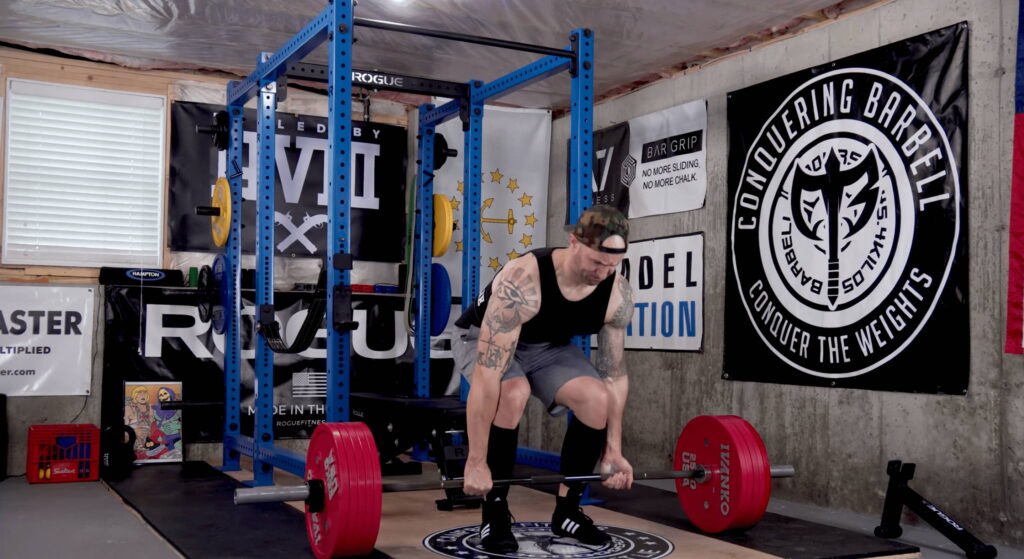
Provides ankle support
Wrestling shoes for powerlifting offer additional ankle support. Although this feature of the construction is not crucial to performance and is not as particular as heel-to-toe drop and sole construction, it nevertheless has the potential to be significant for some people.
You will enjoy the overall fit and feel of wrestling shoes if you prefer added ankle support as you work out. Different weightlifting shoes offer varying levels of ankle support, but nevertheless, they can give the ankle an extra layer of proprioceptive support when lifting weights.
Improves connection to the ground
The thin rubber sole of a wrestling shoe can offer a decent level of ground feedback for a range of lifting movements. More specifically, you want to make sure that your feet are firmly planted and that you can feel the ground beneath you when performing exercises like the squat and deadlift.
When you lift weights, the thin rubber soles wrestling shoes have can assist you to improve on different performance facets. A thinner sole will enable you to “feel” the floor better. Your ability to engage with the ground and make use of the foot’s musculature to keep you upright and planted is improved when there is less material between the foot and the floor.
This may serve as a benefit for any movement involving the lower body in which you want to increase the amount of the foot’s surface area that is actually in contact with the ground. It’s crucial to remember, however, that this does not imply that the thin rubber sole of a wrestling shoe is the only kind of shoe sole that is effective for working out.
For squats, some lifters prefer a shoe that is thinner and flatter, while others prefer a weightlifting shoe with a higher heel. It comes down to personal taste and an awareness of how different types of footwear will affect your biomechanics in various ways.
Moreover, a thinner sole will aid in reducing the range of motion required for exercises like deadlifts. A thin sole can also help to guarantee that you aren’t exerting more range of motion than necessary during exercises like deadlifts, as we briefly covered in our heel-to-toe drop section.
A thin sole might not seem like a significant concern for a novice, but if you’re truly aiming to optimize your performance output, it could be more crucial to make sure that every skill-focused element of your lifting and training is perfect.
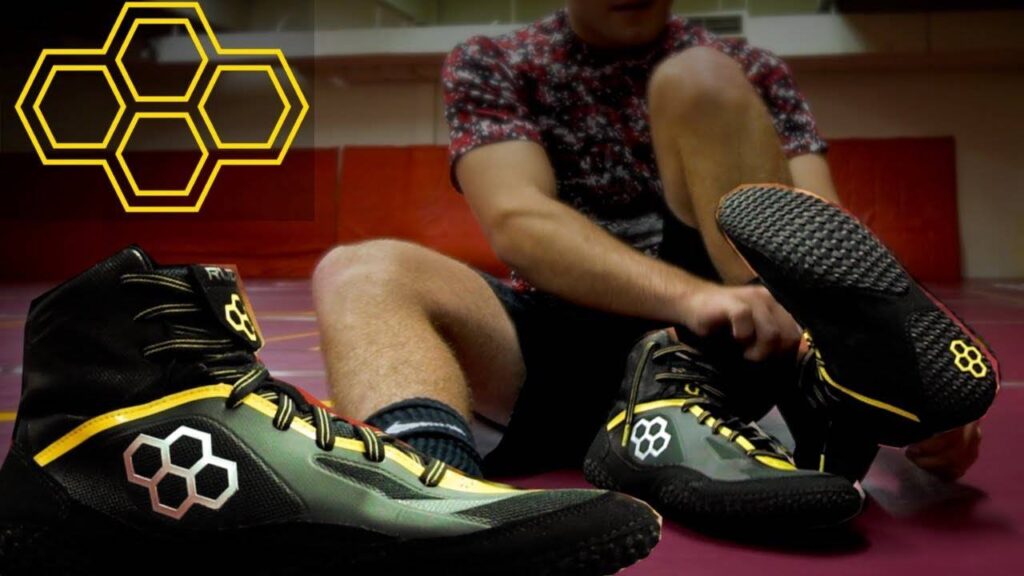
Enhanced sole durability
Compared to other sports shoes, wrestling shoes feature much higher-quality soles. The explanation is that the sole is subjected to significant force from the wrestler’s foot and the sole must be able to absorb the shock.
Squats and virtually all other lifts are also believed to induce the same thing, making the wrestling shoes ideal for these exercises. Consequently, your feet won’t be as swollen following an exercise. If you are a serious lifter, you may have noticed that after a workout, some parts of your foot just hurt and swell more. Basically, the shock-absorbing sole of wrestling shoes lessens discomfort and swelling making it beneficial for those who experience such.
Why wrestling shoes may not be the best for lifting
Does not support poor ankle mobility
You need to have adequate ankle mobility to squat in a flat-soled shoe such as a wrestling shoe. This is the biggest factor to consider before trying out wrestling shoes.
Fortunately, there’s a quick and easy way to test this. You can tell whether you have enough ankle mobility for wrestling shoes if you can perform a full bodyweight squat barefoot with your heels staying completely flat on the ground the entire time. If not, this may lead to you falling out of balance.
Wearing wrestling shoes is still technically acceptable if your heels rise off the ground when you are squatting. However, you will need to perform some short-term ankle mobility exercises to increase your range of motion first. Otherwise, you may be better off using weightlifting shoes that offer an elevated heel to accommodate and support your limited ankle mobility.
May increase susceptibility to low back pain
While the flat sole of the wrestling shoes will make you more aware of where your feet are in relation to one another and make you feel more in control overall, your technique may vary slightly.
People usually lean slightly forward with their chest to maintain stability, which puts stress on the lower back by increasing the shear force induced to the region. This is especially true when a substantial external load is involved, as it is when you lift. If you already have lower back problems, it may be best to use weightlifting shoes instead.
May increase susceptibility to foot pain
If you’re used to squatting with weightlifting shoes, the elevated heel provides an environment where your ankle may slack off. Now if you suddenly switch to wrestling shoes that offer no elevation, you may feel some pain or discomfort since your feet can’t relax as much.
This usually applies to those who squat heavier weights. If the lift is performed with flat shoes on, the added pressure from the external load increases the stress on the feet.
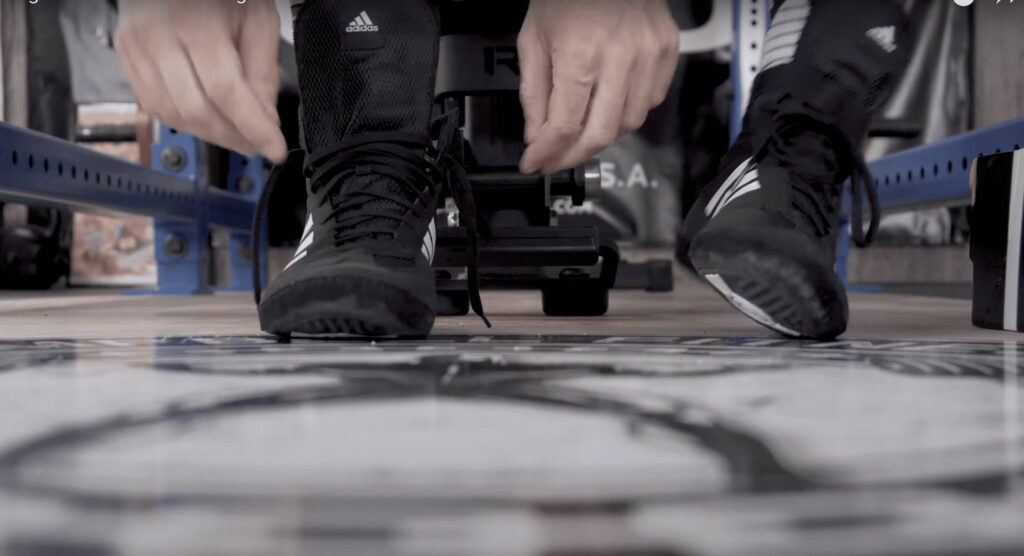
Best wrestling shoes for lifting
My personal favorite whenever I train is the Adidas HVC Wrestling Shoes. It’s the most lightweight I’ve tried without sacrificing longevity as I’ve had it for quite some time now with no issues. I also find having incredible grip with these and not to mention the extra support the ankle strap offers. Whenever I feel like focusing on my ankle’s mobility during training, I definitely reach out for these wrestling shoes.
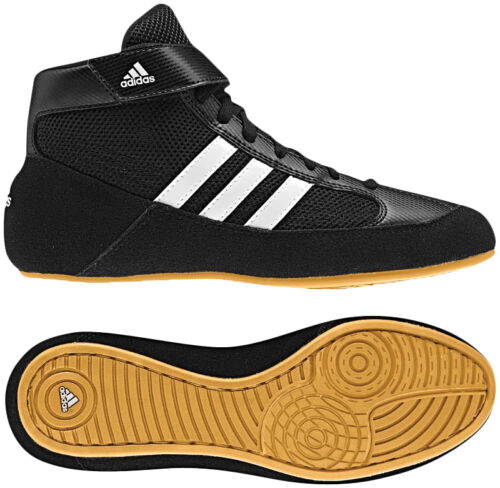
Alternative Option – NOBULL Gum Outwork
If you’d like to have options, I have you covered. NOBULL’s Outwork shoes are another excellent choice. They’re practically indestructible and you can expect to have them for years.
The low drop, supportive design promotes optimal form and reduces the risk of injury, while a wide toe box allows for better foot splay, which helps with balance and control. The low stack height keeps you close to the ground and improves connection with the floor, which is ideal for natural balance and movement.
FAQ
Are wrestling shoes good for deadlifting?
Yes, wrestling shoes are definitely beneficial when you’re performing a deadlift. Wrestling shoes for deadlift have all the characteristics necessary to perform the deadlift safely and effectively, including strong ankle support, a flat sole to reduce the range of motion, and a gripping outer sole to prevent slipping.
Are wrestling shoes good for squats?
Wrestling shoes should work great for squats, but only if you have good ankle mobility and if you’re used to squatting barefoot or with flat shoes. As discussed above, people with poor ankle range of motion may benefit from elevated heels as these accommodate insufficient mobility. Otherwise, if you have no issues with your range, you can definitely enjoy using wrestling shoes for squatting.
Do powerlifters use wrestling shoes?
Yes, a lot of powerlifters frequently opt to train while wearing wrestling shoes. This is because wrestling shoes have flat soles, which enhances your feet-ground connection. You’ll feel more balanced while squatting as a result, and you’ll be able to produce the most power and force possible.
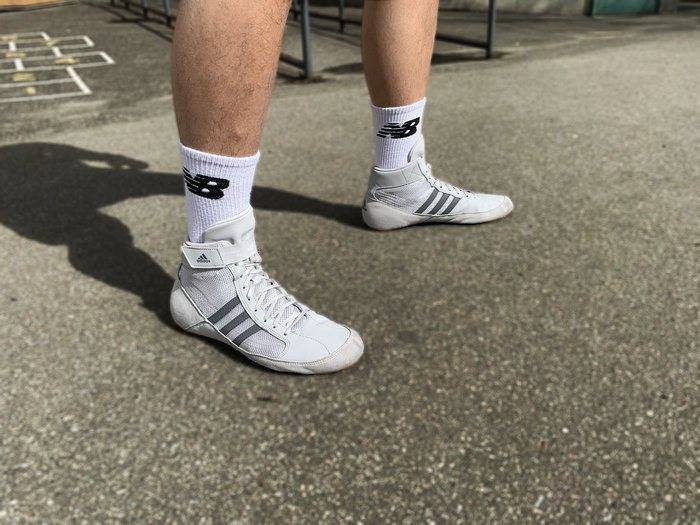
Conclusion
Wrestling shoes are a great option for weightlifting, thanks to their flat and thin soles, outstanding ankle support, and durable build. They offer increased awareness and enhanced connection to the ground to allow you to train with maximized safety.
Don’t forget to share your thoughts or leave some questions in the comment section below.
Also read:
- Are Vans Good for Weightlifting
- Are Basketball Shoes Good for Lifting
- Deadlifting With Squat Shoes
- Are Converse Good for Weightlifting
- Deadlift Shoes Guide
- Weightlifting Shoes Guide
References:
- 5 Causes of Swollen Legs After Exercise // LiveStrong: https://www.livestrong.com/article/413436-swollen-legs-after-exercise/
- Comparison of Back Squat Kinematics between Barefoot and Shoe Conditions // International Journal of Sports Science & Coaching: https://journals.sagepub.com/doi/abs/10.1260/1747-9541.8.3.571
- The loads on the lumbar spine during extreme weight lifting // PubMed: https://pubmed.ncbi.nlm.nih.gov/3589805/
Why Trust Us?
With over 20 years in Olympic weightlifting, strength training, nutrition coaching, and general fitness our team does its best to provide the audience with ultimate support and meet the needs and requirements of advanced athletes and professional lifters, as well as people who strive to open new opportunities and develop their physical capabilities with us.
By trusting the recommendations of our certified experts in coaching, nutrition, and sports training programming, as well as scientific consultants, and physiotherapists, we provide you with thorough, well-considered, and scientifically proven content. All the information given in the articles concerning workout programming, separate exercises, and athletic performance, in general, is based on verified data.
The product testing process is described in more detail here.
Author: Ihor Shymechko
Pro Olympic Weightlifter, Coach
Best Results: Snatch – 208 kg,
C&J – 240 kg
Ihor has been a professional weightlifter since 1996, boasting over two decades of competition experience. His notable achievements include clinching the European Championship in 2009 and securing a silver medal in the 105kg division at the Senior World Championships in 2011. Ihor represented his country in the 2008, 2012, and 2016 Summer Olympics. After retiring from competitive weightlifting, he transitioned to coaching, leveraging his vast experience to guide athletes who now compete on both national and international stages.



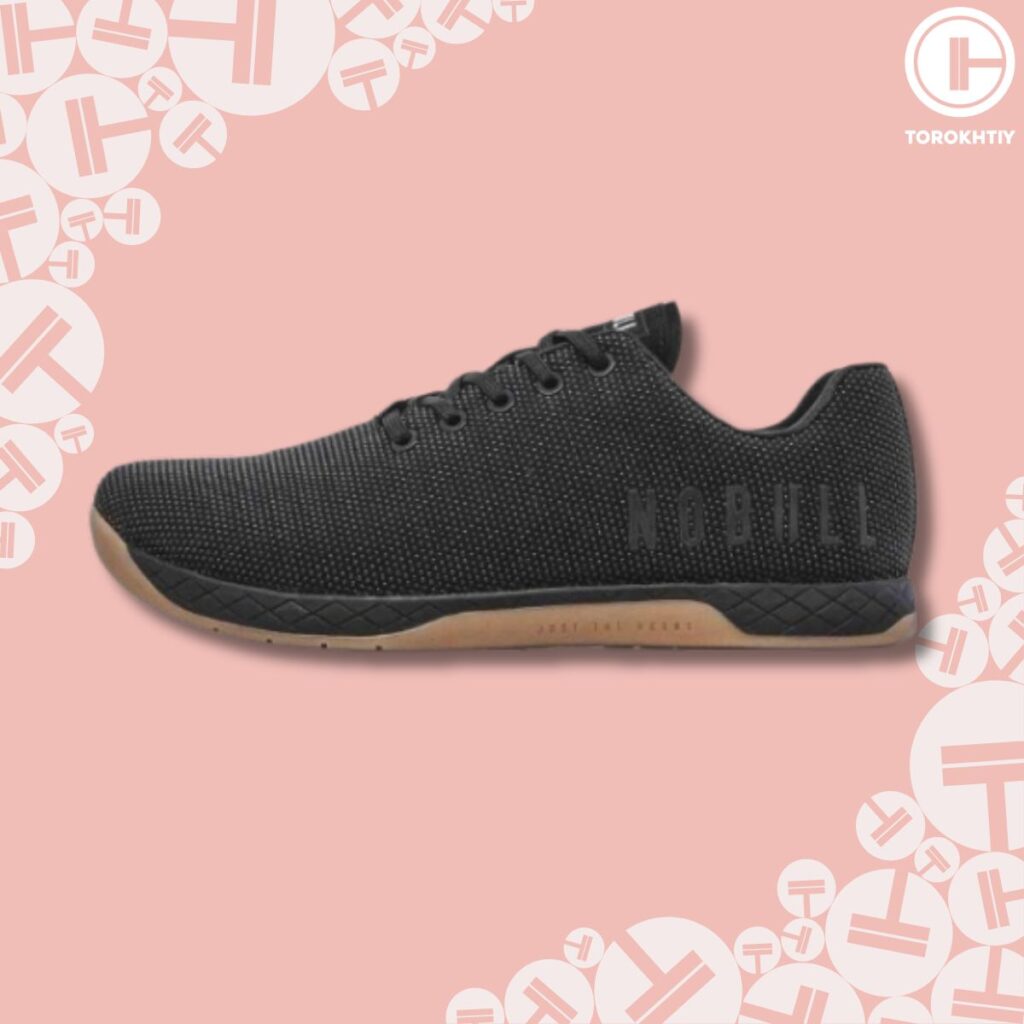
Still have questions after reading our article? Unlock your full potential by engaging with our experts and community! Don’t hesitate — leave a comment below and Ihor Shymechko will provide a personalized answer and insights to help you reach your goals.